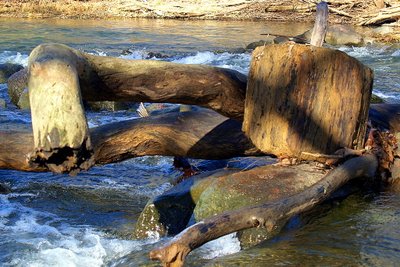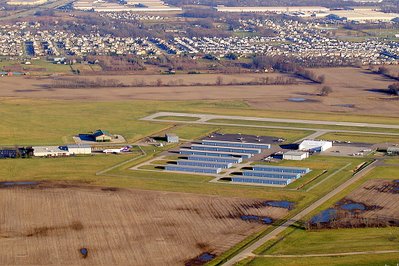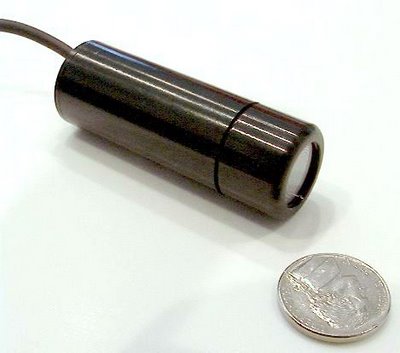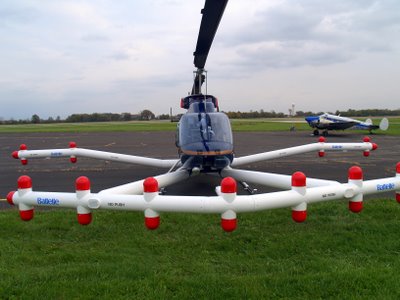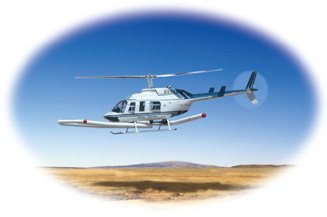Unquestionably flyable great Fall weather today, although the breeze did have a puppy-like bite to it. It's no longer possible for me to live in denial - winter is coming. Maybe not today. Maybe not tomorrow, but soon and for the rest of... or however that goes. I had been hoping for a nice enough day to go to a fly-in over in Urbana. This is a really neat fly-in where the residents of a local retirement community come out to visit. It seemed just the thing for co-pilot Egg and me to do, so I got it on her schedule days ago despite the risk that doing so would trigger my ongoing bad weather karmic retribution. It seems I must have balanced the karmic books with some recent unremarked good deed based on today's experience, though.
I hadn't gassed up since the river run last week, so we decided on a pit stop at MadCo. At $3.44 a gallon I had expected that it might be a tad crowded, but Blimey! By the time I left I think there were five RVs and a couple of store boughts waiting for gas, and we had waited behind two others. The landing at MadCo was ok, but had 5 or 6 of those little baby bumps I get when I carry too much speed down final. Co-pilot Egg is a landing perfectionist and rated it at only a middling effort. 'Tis a fair cop.
It's only a few minutes from MadCo to Urbana, hardly enough time for a single "are we there yet?" to come through the headsets. The pattern was surprisingly empty, allowing me to concentrate on trying for a better landing, and hopefully performing well enough to win the rare and coveted "thumbs-up" rating from this particular co-pilot. Well, depending on how you look at it, I did or I didn't. I did reduce the number of bounces to 3, but they were not baby bumps! This, again, is why I
always try to arrive first! Egg had no comment. It's perks like that that keep me paying her allowance.
We parked in front of the restaurant and walked down to the hangar where the gathering was. The five RVs from MadCo were going to be doing fly-bys soon and I wanted to get back to take pictures, so I left Egg at the hangar where she lived her dream of actually
making sno-cones, cotton candy, and theatre-style popcorn. It's not that she has carney in her blood, it's that those are three of her four personal food groups. The fourth, the hot dog group, was also easily available nearby if she wanted to avail herself of the opportunity to corner the market on all four at once. The Pilot was more than a wee bit nervous as to what the state of the Co-pilot's tummy might be on the bumpy ride home if she was left to her devices for any length of time, as you can imagine.


I'm still struggling with getting decent ground-to-air pictures:


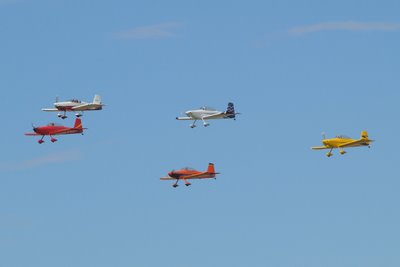
Private to Rick Lee: what should I be looking for in the camera settings to get better ground-to-air pix?? It seems that I have to do a tremendous amount of Picasa hammering with fill light, saturation, and other gadgetry to get something more or less presentable, and those are the ones that turned out
good to start with compared to the rest.
The coordinators of the fly-in had gone all out and provided us with these meal cards:

That was such a generous and unexpected offer that I was tempted to keep mine as a souvenir, but hunger got the better of me. Lunch was a community affair in the second dining room of the diner, where I enjoyed a healthy slice of the Day's Special ham loaf. Once fed, I wanted to grab a slice of pie (it was going fast, and coming home without pie is unthinkable!) for the missus, get it paid for, and head back down to the hangar to check up on Egg. It struck me once I got home that I had left the lunch table in such a rush that I had forgotten to tip the waitress! Arghhh! What a swell representative for the RV pilot community
I am: sit there and enjoy a free lunch and then stiff the waitress! And darned if I hadn't
just gotten my karma back in balance too! I'll have to go back next Sunday and see what I can do to make amends.
When I got to the hangar, Egg was doing fine and was happily dispensing sno-cones to people in heavy jackets and blankets. I swear, she could sell water to Noah.
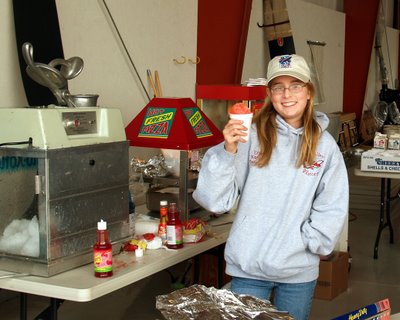 Rick
Rick will recognize the hat: it's the
Girls With Wings hat we searched the four vendor halls for on a really hot afternoon at Oshkosh. I remember squatting down in front of the little fan they had at their booth, just trying to get a little cooled off after the exhausting slog through the jungle of Oshkosh mid-afternoon crowds. Well, she loves it, so it was worth the effort.

While I was at the hangar checking on the co-pilot, the formation groups were briefing to depart. Jeff, the organizer of the event, asked me to jump in his 7A and see if we could get a few pictures as they did their fly-bys. I had the short lens on the camera, but since I've had mixed results with the long lens in air-to-air work and it was inconveniently sitting back in the airplane anyway, I decided to give the shorter lens a try. Results were mixed. We never really caught up with the formation, so I couldn't get close enough for good shots. When we did catch up with four that were flying home westbound, the sun was in the background and that never works out well.
See if you can guess what tickles me so much about this picture:

If you guessed that it's the woman on the right taking our picture at the same time I was taking hers, you win the prize.
Even though the pictures didn't work out, it was a blast to ride in that plane! It sealed the decision that my next RV will have at least 180hp and a constant speed prop. It's not that my plane is slow on 150 horsepower (we did 162 knots each way today), it's just that the 180 hp really, really gets up and goes, provides climb on demand like this month's Dow, and it's smoooooth. I really liked the panel, too. Jeff let me fly for a few minutes and I used that time to try flying by reference to the
Dynon D-10A for my first time. I liked it, but I think I would install at least a 2 1/4" vertical speed gauge too if I were to go to a glass panel, and probably not for the reason you'd guess. Yes, for redundancy to some degree (were you thinking that?), but also for ease of interpretation in a quick scan. Let's put it this way: the numeric vertical speed indication on the Dynon was not a comfortable replacement for the immediate graphical depiction of the pitot-static vertical speed gauge that I'm used to, and I don't know if it ever would be. Keep in mind, though, that I was sitting in the right seat and had to look askance at the Dynon - not the best way to view LCD devices - so I may have missed something. In any event, that's just a tidbit for me to file away for future reference should I ever get the opportunity to design my own panel. I know for sure that I'd go for glass at least with the primary display like Jeff's, and probably engine management as well.
It felt strange riding in a nosewheel RV (this was my first), but only until we were off of the ground. After that it was pure RV. I am a little sore in my left leg from the flight, though. One thing that one apparently
must remember when going from a taildragger to an A is that the step down from the wing of the A is much higher than the step down from the wing of a taildragger. If one were to forget that, even momentarily, and blithley step from the wing without aid of the side step, one might ignomiously lurch from the wing to the ground and hyperextend one's leg a painful manner. Don't ask me how I know - that's one of the perks of owning the blog.
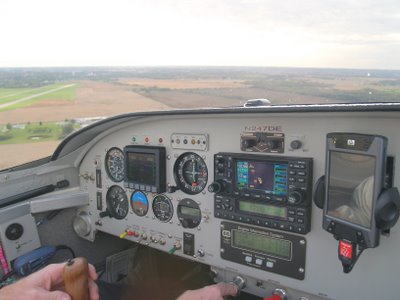
On the way back to the airport, we circled around the retirement community so I could try to get some shots. The autofocus struggled with the tight turn, but it managed to lock on for at least these two:

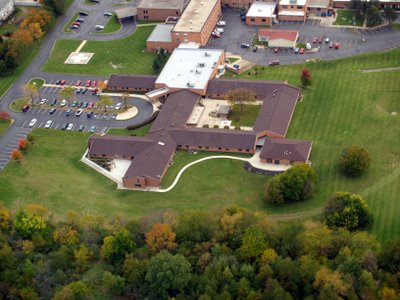
Once back at the airport, I broke Egg away from her newly beloved sno-cone machine and we saddled up to head home. You know it was a successful trip when you're both reluctant to leave, but it was getting late and we needed to get back. The fly-in ended up hosting nearly 20 RVs, and despite the slightly chilly weather I think everyone had a good time. I think it will be easy to get this one back on to her schedule next year. In fact, she has already mentioned that she'd like to go again, and how good it felt to "help the elderly get out for some fresh air and sugar."
They had a band at the fly-in, and it led to one of those weird little coincidences for me. You know how you can go years without hearing a song? That's how I was until just last week when the topic of the song "
Amie, what you going to do?" came up at work. I'll give you one guess as to what these guys were singing:

Oh, and before I forget: the landing back at Bolton? Thumbs-up!!


























